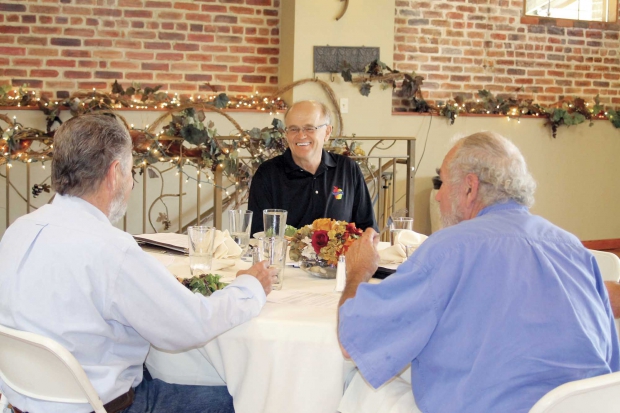
Kirk Mayer (center) chats with former board presidents Jim Koempel (left) and Richard Thomason during the Washington Growers Clearing House Association’s last board meeting. (Geraldine Warner/Good Fruit Grower)
During his four decades working at the Washington Growers Clearing House Association, Kirk Mayer saw the Washington apple crop grow from 25 million boxes to 140 million and availability of labor become an increasing concern.
Mayer, who retired this year, joined the Clearing House in 1972, aged 24, as assistant to manager Leo Sax. He had graduated from Washington State University with a bachelor’s degree in business administration and worked for a couple of years at Grange Supply in Spokane.
The Clearing House’s mission was to provide marketing information to growers and encourage grower involvement in industry and regulatory affairs.
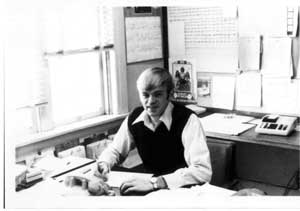
Kirk Mayer pictured in 1976, four years after joining the Washington Growers Clearing House Association as assistant manager.
Mayer’s job was to collect and record data on crop volume, movement, and prices. He did so by hand, carefully noting the figures on a large sheet of engineer’s graph paper that he spread out on a makeshift desk made from an old door with legs attached. Only five apple varieties—Delicious, Golden Delicious, Winesap, Rome Beauty, and Jonathan—were produced in large enough volumes to be tracked.
The association produced a weekly mimeographed bulletin on yellow legal-sized paper showing crop movement and prices and marketing news. Metal plates with the addresses of each recipient were inserted into an addressograph machine, then the bulletins were inserted individually into a cast-iron folding machine before dropped in the mail.
“I had graph paper to start with, and now the data’s all in the cloud,” Mayer reflected. “It just boggles the mind.”
When Sax retired in 1997, Mayer succeeded him as manager. Dan Kelly, who had experience in apple marketing, was hired as assistant manager and took over the data management.
Worker housing
Since then, Mayer has focused primarily on representing growers in regulatory issues, with worker housing and farm-worker safety topping the list. Washington’s production has been on a steady upward trajectory, and worker housing has become more of an issue.
Landlords in general couldn’t afford to provide housing for people who would be there for only a few months of the year, and growers who allowed workers to camp at their orchards found it difficult to meet federal, state, and local regulations. For example, tents had to be provided by the employer and they had to be seven feet tall.
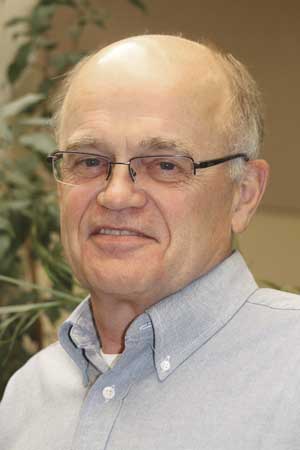
Kirk Mayer
“There were a lot of restrictions,” Mayer said. “It was very difficult for the tree fruit growers to understand and comply with all the rules and regulations. They were doing things based on common sense, but the regulatory issues were above and beyond that.”
The Clearing House worked with state agencies to change the regulations and expand funding for providing seasonal housing. After the Washington Growers League was formed in 1987, the two organizations collaborated.
Mayer estimates he’s been involved in 30 to 40 work groups focusing mainly on labor issues. This year, he was appointed by Governor Jay Inslee to the new Farm Work Group, which is made up of five farmworker advocates and five members representing farmers.
Not being a grower himself, Mayer relied heavily on his board of directors to keep him informed and encouraged growers to provide input themselves.
Serving on such groups has not been without its frustrations, Mayer said. “I could not believe how many times I would be on a committee with individuals who thought that the industry could produce a crop without spraying,” he said. “Another one was that people didn’t realize that organic growers sprayed.
“There’s always frustrations on the work groups,” he said, “But I imagine the other side also had their frustrations.”
Harvest
Mayer said there’s one thing that’s always surprised him, and that’s how migrant workers always “miraculously” arrived to harvest the crop.
“We had millions of dollars invested in a crop, and 30 percent of the workforce in the area, so you rely on 60 to 70 percent of the workforce coming from some other geographic area. And they arrived!”
Currently, the tree fruit industry employs 10,000 to 15,000 people year round, but needs about 65,000 people for cherry harvest, which peaks in July, and then 65,000 people again in the fall to harvest apples. Some of those people live in worker housing at the orchard, some stay with friends, and some live in community-based housing. Some come through the federal H-2A guest worker program that requires that employers provide housing.
“Labor availability is the number-one issue,” Mayer said, noting that the industry is taking steps to address it by changing the structure of their orchards to make them more conducive to mechanical aids, while some of the larger operations are building more housing.
A decline in membership
Clearing House membership had dropped from a peak of around 2,700 to 1,780 when the association closed and included growers with as few as five acres as well as those with thousands. However, board members had to earn the majority of their income from growing fruit, which eliminated those who owned packing houses in addition to orchards. That might be why there was a perception that the association represented small growers, Mayer said.
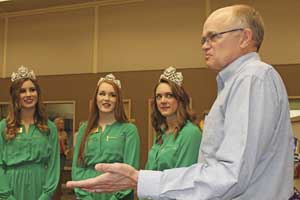
Kirk Mayer received a surprise visit from the Washington Apple Blossom Festival royalty (from left) Princesses Caroline Dahl and Nikara Morgan and Queen Roslyn Thompson, when he was named 2014 Apple Citizen of the Year. (Geraldine Warner/Good Fruit Grower)
The Clearing House had 24 directors, most of whom represented districts in north central Washington and had between 25 and 1,000 acres of orchard.
“We had probably the largest board in the industry, but we also had probably 80 percent attendance,” he said. “I’m pretty proud of the participation in the discussions at our meetings.”
When the proposal came up two years ago to merge the Clearing House with the Wenatchee Valley Traffic Association, Yakima Valley Growers-Shippers, and Washington State Horticultural Association, his board members were concerned that small growers might be overlooked.
“My orders were to try to provide input into the formation of this new association that would ensure that all growers, whether they’re big, small, or medium-sized, would have an opportunity to participate,” he said. “And that’s what we did.”
Mayer, 66, retired at the end of August when the merger took effect. Mattawa grower Frank Lyall, who was on the Clearing House board and also was on the Tree Fruit Industry Consolidation Task Force, said Mayer always had the best interests of the small, medium, and independent grower at heart.
“He is a very selfless individual,” he said. “He worked really hard in representing grower interests. There were few people who were comparable and nobody better than him in understanding regulatory issues and advocating for the industry about the impact of those issues on the industry and small growers in particular.
“I am doubtful, with his retirement, that the same amount of energy and intelligence and direction will be carried forward to that area,” he added.
Mayer said it’s the board of directors that he’ll miss most in his retirement.
“I’ve been lucky over the years to have some pretty knowledgeable people who were willing to share and discuss things openly and give me background one-on-one,” he said. “I owe a heck of a lot to those individuals.” •
______________
Seven decades of grower service
The Washington Growers Clearing House Association was formed in 1941 to provide marketing information to Washington apple growers and help them become profitable again.
In the 1930s, the industry faced tremendous economic challenges, and many growers owed more on their orchards than they were worth. Industry leaders asked the federal government for financial help but were told that the U.S. Department of Agriculture would study the situation first. One of its recommendations was to set up a clearing house to provide marketing information for growers so that when they were selling their crops for cash, they would know the value and be better able to negotiate a fair price, reports Kirk Mayer, who has been on the Clearing House staff since 1972 and became manager in 1997.
Howard Fletcher managed the association for the first five years. He was succeeded by Leo Lowe, with Leo Sax as assistant manager.
“At one time they had a three-person office, and two of them were called Leo,” Mayer said, noting that he’s only known three people called Leo in his entire life, the other being Leo Garcia with Wenatchee Valley College’s agriculture program.
The association closed its doors this year when it merged with the new Washington State Tree Fruit Association, which has assumed its functions.
As a parting gesture, the Clearing House board donated $25,000 to the Washington Agriculture and Forestry Education Foundation to fund a perpetual $1,000 annual scholarship for its leadership program. It also donated $25,000 to the Washington Apple Education Foundation to boost an existing scholarship the Clearing House created in memory of former board member and president Doug Zahn. In addition, it created a $1,000 scholarship available through the WAEF in recognition of Tim Smith’s contributions to the industry. Smith, a Washington State University extension specialist based in Wenatchee, retired this year after 39 years with the university, but he has emeritus status and plans to continue to work for a year or two.
The rest of the Clearing House’s assets were transferred to the new association.


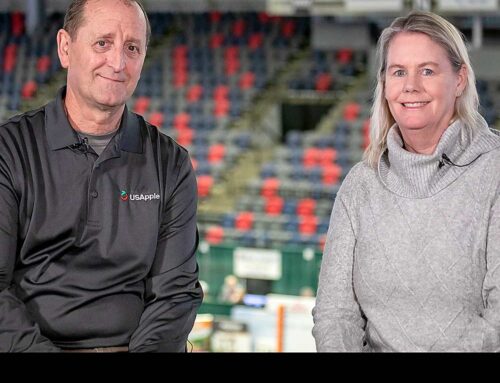
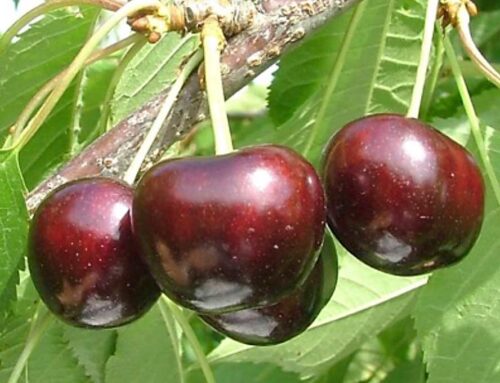
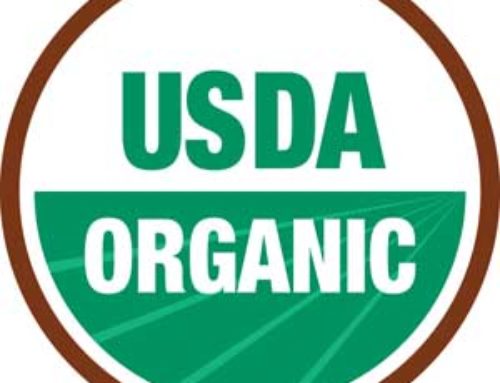

Leave A Comment